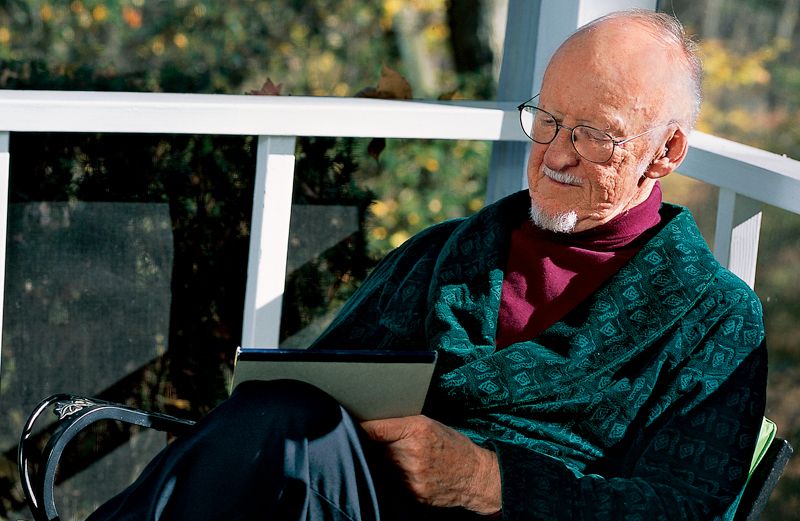I'd never known our friend David Manuel to be so emphatic. My wife, Tib, and I had climbed the steps up to his lighthouse studio overlooking Cape Cod Bay. But David, we quickly learned, hadn't invited us up there for the spectacular view.
"I want to show you something new," he said, pointing us to chairs and handing each of us a pencil and a legal-size yellow pad. "A new way to pray. Imagine yourself climbing the Mount of Olives. You come to a clearing—and there is Jesus, alone, seated on a bench.
"He motions you to join him, invites you to talk to him about anything that's on your mind or in your heart. Write down what you say to him. Listen to his response. Record the whole conversation on your yellow pad."
We are journalists, Tib and I. We have interviewed hundreds if not thousands of people. But this was the most unusual conversation either of us had ever been asked to record.
For an hour we experimented with this technique so unlike our usual inside-our-heads prayer approach.
Back home next morning I got up early, took coffee, pencil and pad out to our porch and, as David instructed, imagined Jesus waiting there for me.
Away from David's lighthouse, however, doubts and questions assailed me. What tone was appropriate? Formal and worshipful, or casual and everyday?
Finally I just plunged ahead. "Well, Lord, here I am," I wrote on the first ruled line. "If you want to know what is really on my mind, it's not very spiritual. I'm worrying about our old car breaking down on our trip south."
I waited and listened, then wrote down what I thought I heard.
That worry is masking a bigger concern. Your own aging. Your own health breaking down.
What? I was feeling great! Well, a few aches and pains maybe, but I wasn't the kind of guy who went running to the doctor with every little complaint. "All right, Lord," I wrote. "You must be right. I'm almost 82 and I'm afraid I won't be able to keep up our travel schedule."
Back and forth the dialogue went—other subjects, other insights, corrections, encouragements. Was I really hearing from God? Or were these just my own thoughts?
In David's lighthouse, I'd jotted down two of his yardsticks for measuring anything I heard: Were the responses in keeping with the personality of Jesus? Were they consistent with Scripture?
Against these standards I found this dialogue acceptable. If it was something important and I had doubts, David also advised, I should check with a trusted and experienced Christian friend.
I put my yellow pad aside, astonished to find that 40 minutes had sped by. I returned to my porch rendezvous every morning for a month. Then Tib and I set out on that editorial trip through the south.
It was our second week on the road, a Thursday in Louisiana, when one of my upper left molars began to throb. Root canal trouble, I thought. The next day the pain spread to the lower jaw.
I phoned my endodontist back in New York. "He says it doesn't sound like a tooth problem," I reported to Tib. By bedtime I was wincing with an earache too.
All night I tossed on the motel bed. The whole left half of my face felt as if it were on fire. By morning it was spotted with red lesions the size of nickels. A little boy saw me in the breakfast room and ran screaming to his mother.
Tib had been on the phone trying to locate a doctor. Naturally it was a Saturday (when else do health crises occur?). I put on dark glasses, pulled my hat down to cover as much of my face as possible and let Tib drive me to the nearest hospital emergency room.
We waited for three hours until the frazzled young physician on duty could see me.
He did a quick examination, took some samples and informed me that I had a bacterial infection. "This should clear it up," he said, writing out a prescription for an antibiotic. "Stop and see another doctor if it doesn't get better."
It didn't. Monday we reached Lindale, Texas, where Tib had a teaching commitment. Lindale was just big enough to support a one-physician clinic. We made an appointment with Dr. Anthony Davis.
He listened to my report of the ER physician's diagnosis and took notes. "This is a textbook case of shingles!" he exploded. I didn't much like the diagnosis. But I liked the confidence in his voice.
Dr. Davis had recognized my problem the minute I walked in. The telltale sign? The lesions on just one side of the face. "I don't see how any…." He stopped himself, but the rest of the sentence hung in the air—how could even an overworked ER doctor have missed something so obvious?
"Shingles is a virus, not a bacterium; antibiotics don't help," he went on. Apparently the disease can appear in anyone who's had chickenpox. The virus lies dormant in the body—in my case for more than 70 years—until some agent reactivates it. "Have you been under stress lately?" Dr. Davis asked.
Of course, I'm under stress, I thought. Who isn't these days? There was the stress of traveling and worrying about our kids and grandkids, and okay, maybe worrying about my health. If stress could trigger shingles, I didn't see how anyone could escape getting the virus.
"Unfortunately," Dr. Davis said, "you've missed the critical window of time." If shingles is treated within 72 hours, he said, you could usually prevent the serious pain which so often persists long after the initial attack.
Dr. Davis gave me a prescription, "just in case we're not too late." As I left, he added the advice doctors are so fond of giving: "Avoid stress."
How was I supposed to do that?
The trip stretched on and so did the pain. The tension made me grind my teeth even in the daytime. I was miserable, and miserable to be with, no doubt. Surly. Snappish. Impatient. One day, as I caught myself with a tight-clenched jaw, I seemed to hear, John, have you forgotten our morning conversations?
Though I'd intended to keep up my prayer-with-a-pencil discipline on the trip, my morning routine was broken and it was easy to forget. Now the horrible pain forced me into action. Sitting in the lobby of a motel in Arkansas the next day, I drew out my pencil and yellow pad.
You're angry, I heard.
"Angry, Lord?" I wrote. "At whom?"
At the doctor who didn't spot shingles.
I knew at once that this was the truth, though I hadn't wanted to admit it. "How can I help it? I have a right to be angry."
Write a letter.
My pencil moved furiously. To whom should I write? The director of the hospital? Threaten them with a malpractice suit? These things would certainly discharge my anger, but…were they consistent with the personality of Jesus?
Somehow I could not imagine him initiating a legal battle. Nor damaging a man's reputation with his employer. However, I could envisage Jesus addressing a poorly performing individual directly—honestly and firmly, yet with understanding.
When Tib and I got home, I wrote the ER doctor. So far I have not heard back. But I've stopped grinding my teeth. Maybe all I needed to do was write that letter.
I've seen six doctors since the onset of shingles, including the head of the pain management clinic at New York Presbyterian. I have lived on Motrin and Neurontin and a cornucopia of other medications.
Four months into this ordeal, the discomfort is finally diminishing, though I still frighten visitors at the front door with the Lidoderm patches I wear for 12 hours a day in strips across the nerve pathways on my face.
Do I still dialogue in the early morning? Yes, indeed. I pray with my pencil. My sessions now extend beyond strictly personal matters—pain and anger have a way of dominating the horizon—to include daily thanksgivings and intercessions, and pleas for simple guidance.
And never before in my life have I felt so close, so connected to God in prayer. That it took a bout with shingles is a price I'm willing to accept.
The doctors' best guess is that it will take another four months before I am pain-free. So I'm on the mend, which is good news. The better news is the new way Tib and I discovered to pray. With pencil in hand.
Download your FREE ebook, A Prayer for Every Need, by Dr. Norman Vincent Peale






